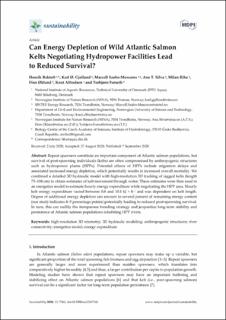| dc.contributor.author | Baktoft, Henrik | |
| dc.contributor.author | Gjelland, Karl Øystein | |
| dc.contributor.author | Szabo-Meszaros, Marcell | |
| dc.contributor.author | Silva, Ana T. | |
| dc.contributor.author | Riha, Milan | |
| dc.contributor.author | Økland, Finn | |
| dc.contributor.author | Alfredsen, Knut | |
| dc.contributor.author | Forseth, Torbjørn | |
| dc.date.accessioned | 2020-09-29T08:00:52Z | |
| dc.date.available | 2020-09-29T08:00:52Z | |
| dc.date.created | 2020-09-07T18:01:47Z | |
| dc.date.issued | 2020 | |
| dc.identifier.citation | Sustainability. 2020, 12 (18), | en_US |
| dc.identifier.issn | 2071-1050 | |
| dc.identifier.uri | https://hdl.handle.net/11250/2680136 | |
| dc.description.abstract | Repeat spawners constitute an important component of Atlantic salmon populations, but survival of post-spawning individuals (kelts) are often compromised by anthropogenic structures such as hydropower plants (HPPs). Potential effects of HPPs include migration delays and associated increased energy depletion, which potentially results in increased overall mortality. We combined a detailed 3D hydraulic model with high-resolution 3D tracking of tagged kelts (length 73–104 cm) to obtain estimates of kelt movement through water. These estimates were then used in an energetics model to estimate hourly energy expenditure while negotiating the HPP area. Hourly kelt energy expenditure varied between 0.8 and 10.1 kJ × h−1 and was dependent on kelt length. Degree of additional energy depletion can amount to several percent of remaining energy content (our study indicates 4–5 percentage points) potentially leading to reduced post-spawning survival. In turn, this can nullify the iteroparous breeding strategy and jeopardize long-term stability and persistence of Atlantic salmon populations inhabiting HPP rivers. | en_US |
| dc.language.iso | eng | en_US |
| dc.publisher | MDPI | en_US |
| dc.rights | Navngivelse 4.0 Internasjonal | * |
| dc.rights.uri | http://creativecommons.org/licenses/by/4.0/deed.no | * |
| dc.title | Can Energy Depletion of Wild Atlantic Salmon Kelts Negotiating Hydropower Facilities Lead to Reduced Survival? | en_US |
| dc.type | Peer reviewed | en_US |
| dc.type | Journal article | en_US |
| dc.description.version | publishedVersion | en_US |
| dc.source.volume | 12 | en_US |
| dc.source.journal | Sustainability | en_US |
| dc.source.issue | 18 | en_US |
| dc.identifier.doi | https://doi.org/10.3390/su12187341 | |
| dc.identifier.cristin | 1827896 | |
| dc.relation.project | Norges forskningsråd: 244022 | en_US |
| dc.description.localcode | This is an open access article distributed under the Creative Commons Attribution License which permits unrestricted use, distribution, and reproduction in any medium, provided the original work is properly cited | en_US |
| cristin.ispublished | true | |
| cristin.fulltext | original | |
| cristin.qualitycode | 1 | |

